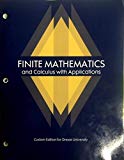
Concept explainers
(a)
To find: The rate of change of the calcium level with respect to time at
(a)
Answer to Problem 63E
The rate of change of the calcium level with respect to time at
Explanation of Solution
The amount of calcium remaining is
The rate of change of the calcium level with respect to time is given by,
The rate of change of the calcium level at
Hence, rate of change of the calcium level at
(b)
To find: The rate of change of the calcium level with respect to time at
(b)
Answer to Problem 63E
The rate of change of the calcium level with respect to time at
Explanation of Solution
The amount of calcium remaining is
From part (a), the rate of change of the calcium level with respect to time is
The rate of change of the calcium level at
Hence, rate of change of the calcium level at
(c)
To find: The rate of change of the calcium level with respect to time at
(c)
Answer to Problem 63E
The rate of change of the calcium level with respect to time at
Explanation of Solution
The amount of calcium remaining is
From part (a), the rate of change of the calcium level with respect to time is
The rate of change of the calcium level at
Hence, rate of change of the calcium level at
(d)
Whether C is always increasing or decreasing; explain how to determine.
(d)
Answer to Problem 63E
The Calcium remaining in the blood stream is always decreasing.
Explanation of Solution
The amount of calcium remaining is
From part (a), the rate of change of the calcium level with respect to time is
From the parts (a), (b), and (c), observe that
Thus, the amount of calcium in the blood will decrease with respect to time is decreasing gradually.
Want to see more full solutions like this?
Chapter 12 Solutions
Finite Mathematics and Calculus with Applications
- a -> f(x) = f(x) = [x] show that whether f is continuous function or not(by using theorem) Muslim_mathsarrow_forwardUse Green's Theorem to evaluate F. dr, where F = (√+4y, 2x + √√) and C consists of the arc of the curve y = 4x - x² from (0,0) to (4,0) and the line segment from (4,0) to (0,0).arrow_forwardEvaluate F. dr where F(x, y, z) = (2yz cos(xyz), 2xzcos(xyz), 2xy cos(xyz)) and C is the line π 1 1 segment starting at the point (8, ' and ending at the point (3, 2 3'6arrow_forward
- I need help in ensuring that I explain it propleryy in the simplifest way as possiblearrow_forwardI need help making sure that I explain this part accutartly.arrow_forwardPlease help me with this question as I want to know how can I perform the partial fraction decompostion on this alebgric equation to find the time-domain of y(t)arrow_forward
- Please help me with this question as I want to know how can I perform the partial fraction on this alebgric equation to find the time-domain of y(t)arrow_forwardEvaluate F³ - dr where ♬ = (4z, -4y, x), and C' is given by (t) = (sin(t), t, cos(t)), 0≤t≤ñ .arrow_forwardMid-Term Review Find the formula for (f + g)(x). f(x) = x² - 10x + 25 and g(x) = x² - 10x + 24 (f + g) (x) = [ 2 ]x² X + DELL Skip Sarrow_forward
 Linear Algebra: A Modern IntroductionAlgebraISBN:9781285463247Author:David PoolePublisher:Cengage Learning
Linear Algebra: A Modern IntroductionAlgebraISBN:9781285463247Author:David PoolePublisher:Cengage Learning
 Trigonometry (MindTap Course List)TrigonometryISBN:9781337278461Author:Ron LarsonPublisher:Cengage Learning
Trigonometry (MindTap Course List)TrigonometryISBN:9781337278461Author:Ron LarsonPublisher:Cengage Learning
 College AlgebraAlgebraISBN:9781305115545Author:James Stewart, Lothar Redlin, Saleem WatsonPublisher:Cengage LearningAlgebra & Trigonometry with Analytic GeometryAlgebraISBN:9781133382119Author:SwokowskiPublisher:Cengage
College AlgebraAlgebraISBN:9781305115545Author:James Stewart, Lothar Redlin, Saleem WatsonPublisher:Cengage LearningAlgebra & Trigonometry with Analytic GeometryAlgebraISBN:9781133382119Author:SwokowskiPublisher:Cengage





